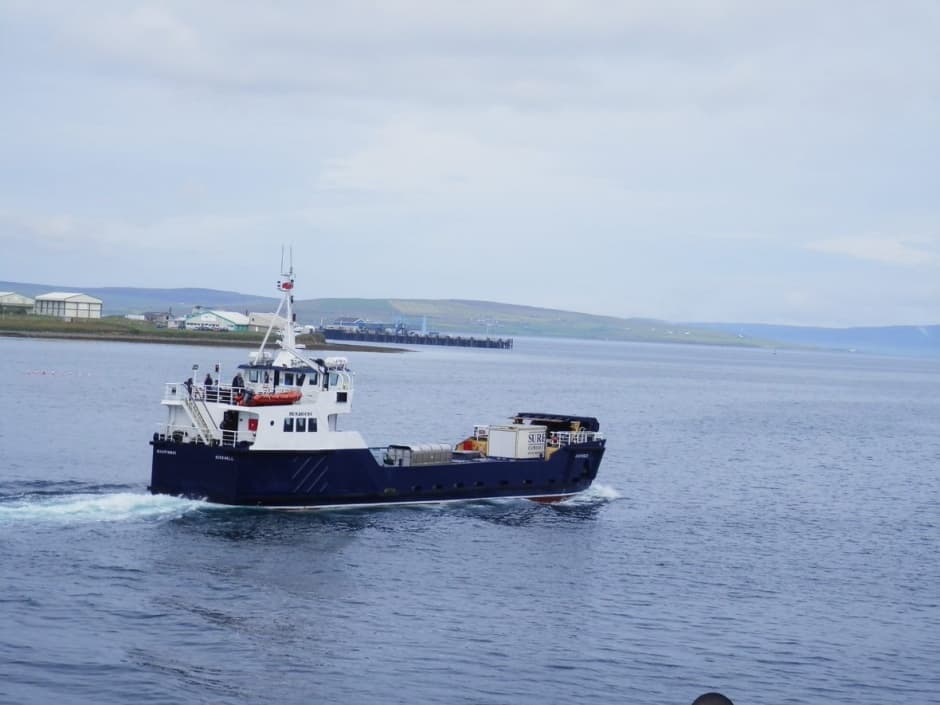Life in the Orkney Islands depends on ferries more than anywhere else in the UK. Twenty of the 70 islands in the archipelago 16km off the north coast of Caithness are inhabited, and their residents depend on the regular network of small ferries that ply the heavily tidal channels between the islands for communication, provisions, education and many aspects of their everyday existence.
Orkney is also one of the UK’s major centres for renewable energy: the European Marine Energy Centre (EMEC) is sited in its second-largest town, Stromness, and the wave and tidal systems it is testing are connected to the grid, wind turbines are commonplace (offshore turbines must be used onshore, because the winds are so strong) and the mainland has pioneered the use of hydrogen generated by renewable energy for several applications.

The latest of these applications, the use of hydrogen directly injected into the fuel supply of one of the ferries, has now been funded by Innovate UK. The HyDIME project (Hydrogen Diesel Injection in a Marine Environment), which formally started on 1 August, has been granted £430,000 to design and integrate a hydrogen diesel dual fuel injection system. The 12-month project is intended to de-risk the technology, which will be globally unique during the life of the project.
Shapinsay is the eighth largest of the Orkneys, with an area of just under 3000 ha (11 square miles), one village and a population which has hovered around 300 since 2000.
HyDIME will be executed by consortium led by Ferguson Marine Engineering and will also involve the Orkney Islands Council, EMEC, the High-Speed Sustainable Manufacturing Institute (HSSMI) which is headquartered at London’s Olympic Park but has an outpost in Glasgow, and Lloyds Register. It will use renewable energy generated for the island of Eday, of which there is often a surplus which is fed into an electrolyser sited at EMEC’s tidal energy test facilities. The hydrogen generated is currently used for a variety of applications around the archipelago, including generating electricity for the boats docked in the harbour at Kirkwall, Orkney’s capital, generating electricity and heat for two small schools, and powering fuel cell range extenders on a small fleet of vans.
"Orkney has an abundance of renewable electricity which the local grid cannot cope with. This led EMEC to look into alternative ways to store and use electricity so that Orkney’s wind, tidal and wave power potential could be fully realised,” said Jon Clipsham, hydrogen manager at EMEC. “Having invested in an electrolyser to generate hydrogen from Eday’s tidal and wind resources, EMEC has been exploring various opportunities to support the development of a hydrogen economy on the islands. The potential for developing hydrogen powered vessels is one of the most exciting prospects, particularly given the number of carbon-intensive inter-island ferries located here. We’re really excited to be part of this project to create a ferry run on a carbon neutral fuel."
Hydrogen-diesel injection is currently being tested in the automotive sector. Injecting hydrogen into the air-fuel mixture of a diesel engine can improve fuel consumption by 20 to 30 per cent, reduce particulate matter by 85 per cent and cut nitrogen oxides by 50 to 90 per cent. The system is currently being tested on diesel Federal Express trucks in the Seattle area and several other automotive companies are looking at the technology.
As part of HyDIME, Ferguson Marine, in conjunction with the Ultralow Emission Mileage Company (ULEMCo), will develop the design of how the system can work in tandem with existing systems to power auxiliary units on board vessels. Following this, the system will be physically integrated onto the Shapinsay ferry. Meanwhile, HSSMI will carry out a scale up analysis and a techno-economic assessment to determine whether any other region of the UK might be suitable for implementation of a similar hydrogen infrastructure.
“HSSMI have a rich history within the automotive sector, and with a newly opened office in Glasgow, we are looking to transfer our learnings from this industry and our knowledge of advanced manufacturing into different sectors,” said project manager Tristan Coates. “We believe that developing a hydrogen economy within Scotland and the greater UK is essential for decarbonising transportation and energy production. HyDIME is an exciting first step on this journey."




Nanogenerator consumes CO2 to generate electricity
Whoopee, they've solved how to keep a light on but not a lot else.